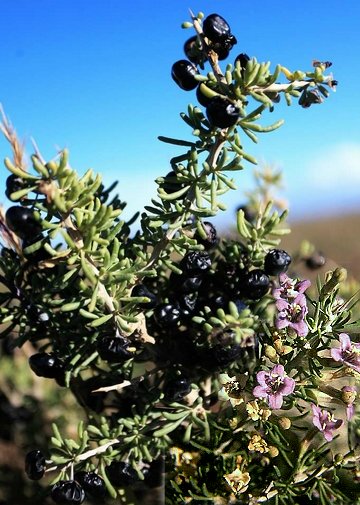
|
|
Black Goji (Lycium ruthenicum Murray).
Flowers and fruits.
|
Black Goji - Lycium ruthenicum Murray
Lycium ruthenicum Murray commonly known as Russian Box Thorn
or Black Goji, is an important plant of Solanaceae family. L. ruthenicum is a native of central Asia and distributed from China to
Afghanistan, Kazakhstan, Kyrgyzstan, Mongolia, Pakistan, Russia, Tajikistan,
Turkmenistan, Uzbekistan, Tibet
and Indian Himalayas. In India, L. ruthenicum commonly grows in Karakoram Range at an altitude of about 3,700 m above mean sea
level. In the Trans-Himalayan Ladakh region, is commonly found in the sandy places of Hunder and Diskit areas of Nubra valley at an altitude of about 3,100 m above mean sea
level. Resistant to drought, often born on
saline-alkali soil or sandy wasteland.
Lycium ruthenicum Murray is a multi thorns
shrub, 20-150 cm. Many branches, twigs hard, often has the curved shape, white. Leaves clustered at the spur 2-6
tablets, fleshy, sessile, strip, strip lanceolate or cylindrical, 5-30 mm long, blunt and round
top. Born on the spur flower flowers 1-2 spines on both sides of the base; pedicels
slender, 5-10 mm; The flowers are hermaphrodite (have both male and female
organs) and are pollinated by Bees and Flies. Calyx narrowly
campanulate, 3-4 mm long, 2-4 lobed; corolla funnel-shaped, tube often more eaves Department lobes 2-3 times
longer, light purple, 1 cm long; stamens of unequal length. Berry spherical, dark purple when
mature, 4-9 mm in diameter; Seeds kidney-shaped, brown. The flowering time is June to August but can sometimes bloom in May
too. Fruits bloom from August to October.
Plants are very drought tolerant and have an extensive root
system. They can be planted to stabilize banks and sandy soils. It is reported that the plants require well drained
soil of moderate quality for better flowering and fruiting and survive in poor saline soils and sunny position.
L. ruthenicum can be sexually propagated through seeds and asexually through stem
cuttings, division of suckers and layering. For better and quick germination seeds are sown in greenhouse during early spring and seedlings are transplanted into individual pots and grown in the greenhouse during first
winter. These are planted in the field during late spring or early summer. To encourage bushy growth the shoot tips of the young plant are pinched
out. It can also be propagated through stem cuttings of half-ripen wood or mature wood of 5-10 cm in height in a cold frame to achieve high propagation
percentage. It is easily propagated through division of suckers and by planting them into their permanent positions during late
winter. L. ruthenicum is extensively cultivated in the Ningxia province of China.
It is surprising to learn that China alone now produces more than five million kilograms of the dried Lycium fruit annually and most of this is for the country’s internal
use. Many people squeeze the fresh fruits to obtain its juice which is concentrated before preserving and the concentrate is used in the preparation of different beverages.
Ripen fruits are eaten raw or cooked. Only the fully ripe fruits should be
eaten.
In India, it grows in Kashmir where it is used by native people as an ointment to treat blindness in camels. In humans, it’s ripe fruits have been used
traditionaly for treatment of heart disease, abnormal menstruation &
menopause. The berries can be used directly for the preparation of infusions simply immersing them in hot water for a few
minutes.
he fruits are the rich source of carotenoids, protein,
polysaccharides, amino acids, vitamins B1, B2, vitamin C; minerals, trace minerals like
iron, zinc and selenium; alkaloid betaine and other phyto-constituents. It is used for the treatment of
diabetes, anemia, vision problems, impotency, lung disorders; it can enhance liver and kidney functions and bolster the immune system to prevent cancer and
AIDS.
This less explored but high value medicinal plant of Indian
Trans-Himalaya, particularly Ladakh has immense importance in traditional system of medicine and proper scientific validation and identification of its novel
bio-active components is required for development of herbal preparations from this
plant. Although this fruit is so rare and under-studied, it’s now apparently contending for the top spot in
so-called “superfoods”.
Source:
http://en.wikipedia.org/wiki/Lycium_ruthenicum
http://massspectrumbotanicals.com/shop/lycium-ruthenicum-murr/
http://www.researchgate.net/profile/Priyanka_Dhar/publication/264936081
